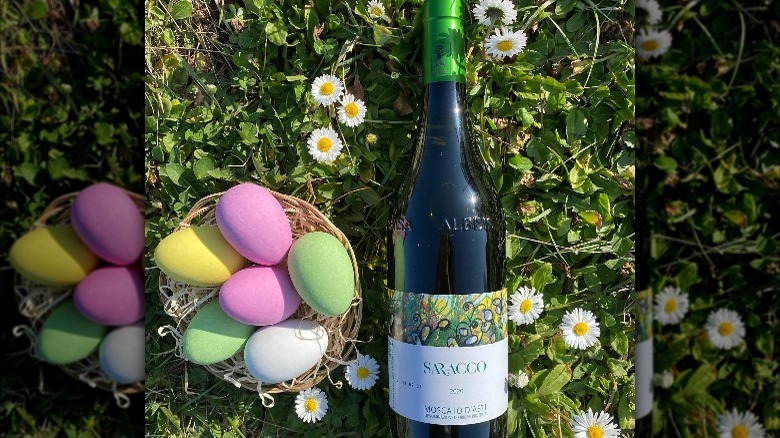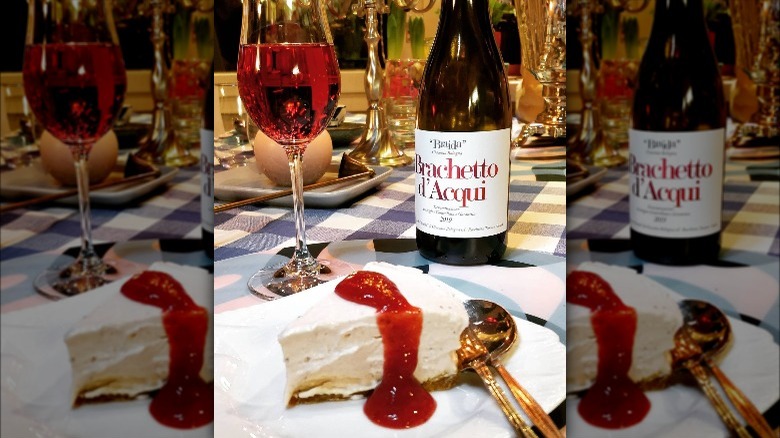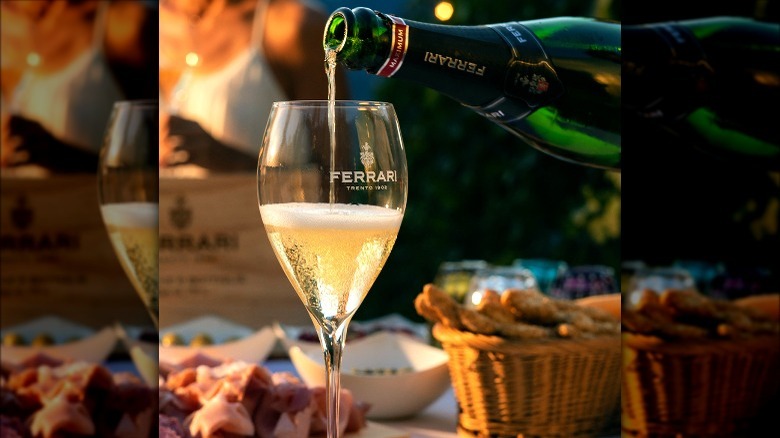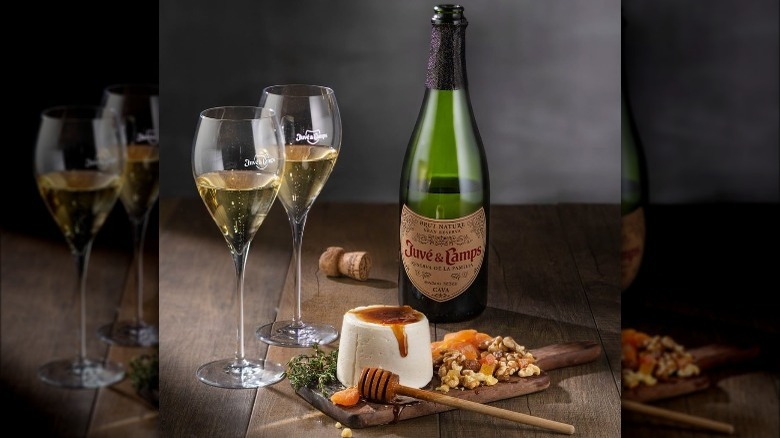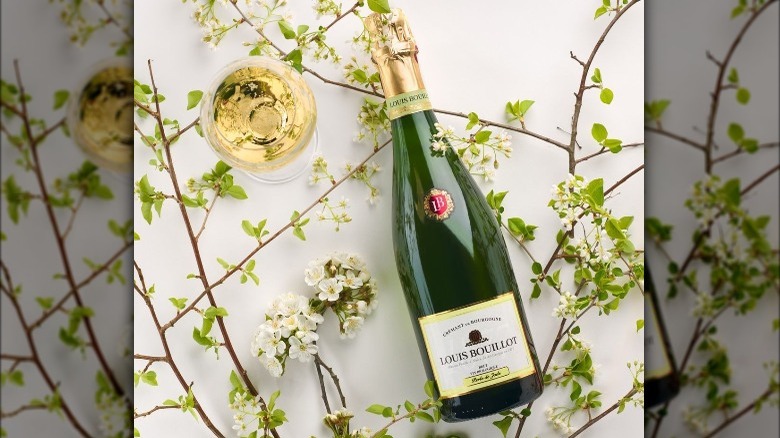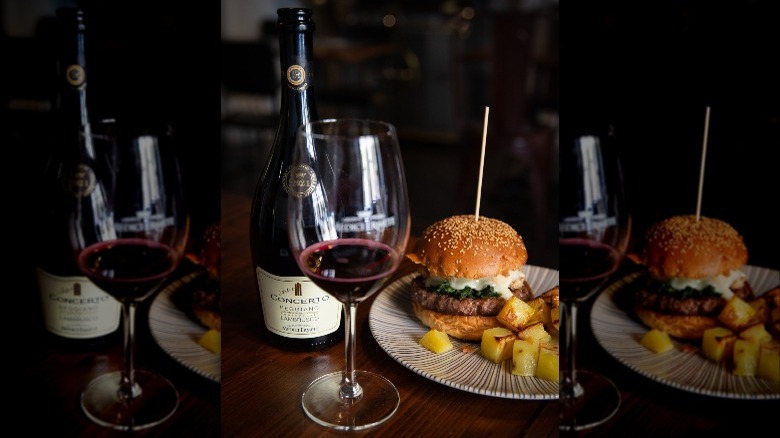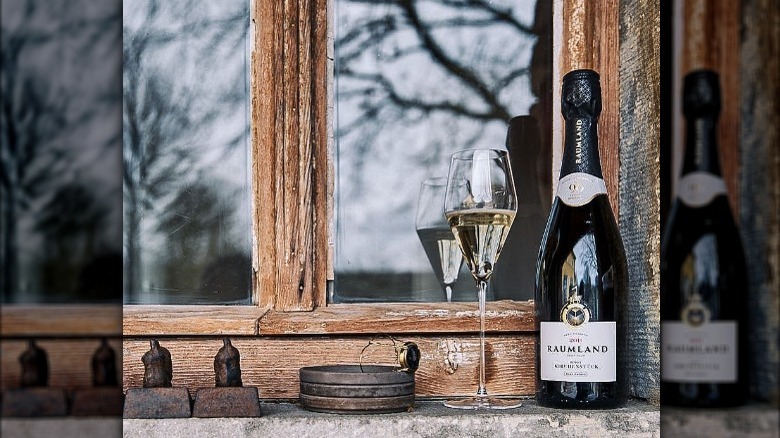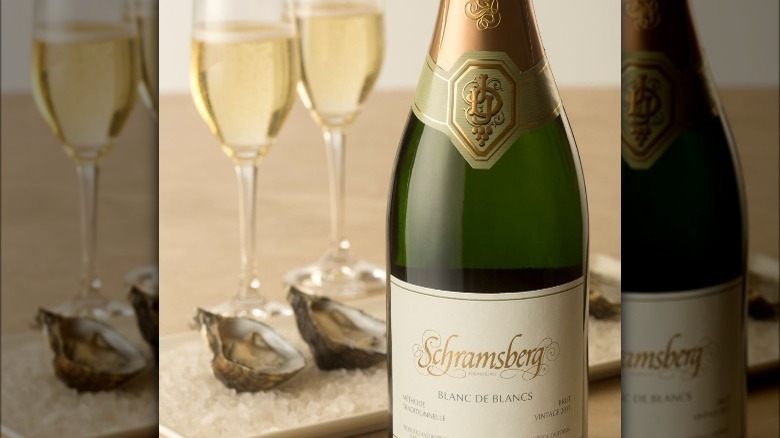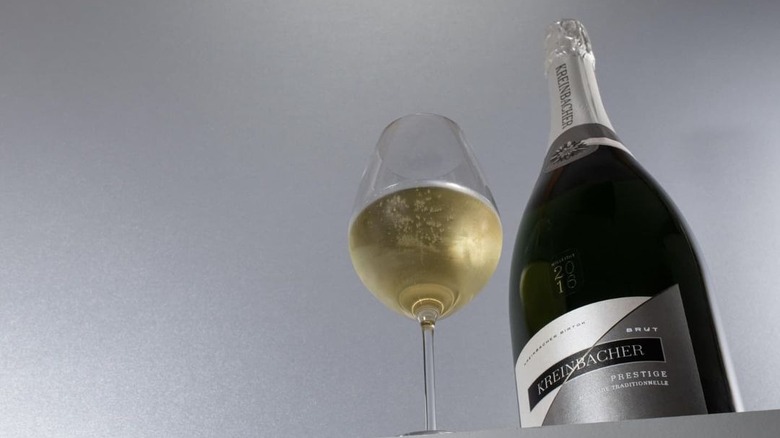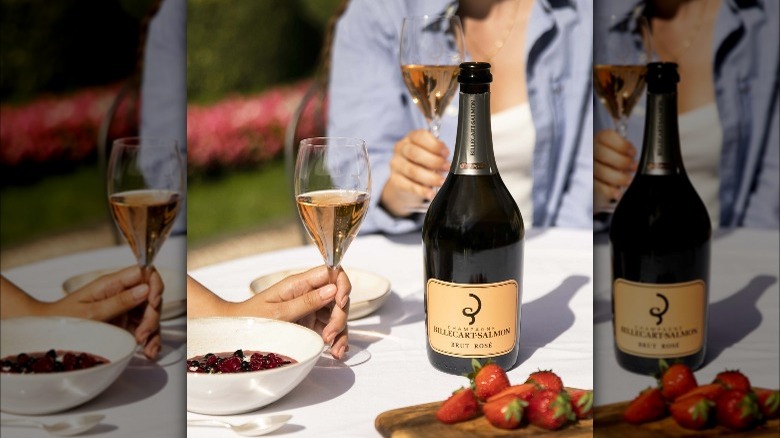20 Different Types Of Sparkling Wines Explained
Bubbly, fizz, sparkling wine — it all makes the same explosive (albeit, celebratory) sound when you pop a bottle. Despite the vast selection of styles, we often think of Champagne and Prosecco as the only contenders. You might know a few others, but can you name 20 off the top of your head?
There are many factors that influence how any wine will taste, and sparkling styles have additional variables that make each unique. The grape varieties in the wine undoubtedly have a large impact, but the method used to develop the bubbles does, too. The three main fermentation processes we will touch upon in our selection are traditional, tank, and ancestral. Each technique highlights different components, creating the nuanced flavors you'll find in any given glass of sparkling wine.
The traditional method is often considered the most prestigious (and time-consuming). It entails making a still wine and bottling it with additional sugar to provoke a secondary fermentation in the bottle. Sealed, the carbon dioxide byproduct has nowhere to go, ultimately settling in the wine as bubbles. The tank (or, Charmat method) simplifies the process by performing the second fermentation in a large pressurized tank before bottling the bubbly wine. Finally, the ancestral method involves bottling and sealing the wine before it completes its first fermentation, effectively blocking carbon dioxide in the bottle and producing bubbles.
Blanquette de Limoux
The name might not be as ubiquitous as other French sparkling wines, but Blanquette de Limoux has quite an impressive history. According to Cellar Tours, this wine from the Languedoc region in Southern France dates back to 1531, courtesy of the local Benedictine monks. It may very well be the first documented bubbly wine in France — depending on who you ask. Although the wine was originally made in the ancestral method by bottling wine that had not yet undergone a complete fermentation, today it's produced using the traditional method.
According to folklore, Blanquette de Limoux may have initially been a happy accident thanks to overzealous winemakers bottling their juice too early. Nonetheless, the result was a success and inspired future bubble enthusiasts. The Limoux AOC dictates the regional standards of production, including the makeup of the grapes. You'll typically find a small percentage of chardonnay with the occasional presence of chenin blanc; however, the overwhelming majority of Blanquette de Limoux comes from an indigenous grape called mauzac or Blanquette (hence the name).
Expect fresh flavors of green apple, pear, and floral honeyed aromas from this uncommon grape. The wine can be made in dry and semi-sweet styles, which pair well with complete meals and desserts respectively. But you can also consume it solo as an apéritif. Try the historical bubbles from Château Rives-Blanques, one of the best local producers.
Moscato d'Asti
You wouldn't expect the Italians to be slacking in the wine department, and indeed, Moscato d'Asti appears to date back to the 14th century. Sourced from Asti in Piedmont, this lightly fizzy wine (frizzante vs more carbonated spumante styles) is traditionally sweet with a low alcohol level of around 5% or 6%. As the name entails, these bubbles are made with the moscato bianco grape, which is known for its intensely aromatic, sweet, floral, and spiced profile, as Wine Searcher describes.
Grapes are collected and fermented at a low temperature in large pressurized tanks until a light sparkle develops. At this point, there's still plenty of sugar in the wine so the bottled result is decidedly sweet. In Italy, this process is referred to as the Martinotti method, named after the Piedmontese man who created the technique, shortly before it was patented by Eugène Charmat from France.
While some people enjoy the sweet sipper solo, it is often served as a dessert wine. Thanks to its fruity nature, Moscato d'Asti is often considered to be a good option for new wine drinkers as it helps ease them into the flavorful world of bubbles. If you're not already on board with bubbles in your wine, begin your journey with a bottle by Saracco.
Brachetto d'Acqui
Italy's impressive viticultural history means that there are always new wines to discover, including sparkling varietals. Brachetto d'Acqui may not be Piedmonte's most famous wine, but the sweet sparkling red sure stands out. The wine gets its name from the grape variety (brachetto) and the region of production — Acqui. According to Piemonte on Wine, the Romans were fond of the stuff and claimed it was an aphrodisiac.
This sparkling red is the perfect sipper if you want to skip dessert but still want something to satisfy your sweet tooth. You'll definitely get your fill of fruity flavors (think strawberry, cherry, raspberry, to name a few) and floral aromas. With a low alcohol level between 5.5% and 7%, you can comfortably enjoy Brachetto d'Acqui chilled on a summer day. Wine Searcher explains that depending on the specifics of fermentation (the Charmat method is typically favored), the resulting wine ranges from lightly sparkling (frizzante) to fully bubbly (spumante).
The wine has its own DOCG, which means that cultivation and production are regulated to ensure consistency and quality. Enjoy it as a sweet drink to ignite a meal, or serve it alongside a slice of dark chocolate cake or berry-based dessert. Braida is a top producer in the region, and its Brachetto d'Aqui is well worth tasting.
Prosecco
Prosecco is one of the most popular sparkling wines, with a production volume to match. According to the Prosecco DOC (one of the regulating bodies that control the production from vineyard to bottle), 486 million bottles are sold annually. Hailing from northeastern Italy, the vineyards date back a couple of thousand years. Both a town and sparkling wine are named Prosecco, but the primary grape variety used in production is officially called glera.
Subareas of the region designate levels of quality and winemaking restrictions, with the hills of Conegliano Valdobbiadene typically considered among the best. In fact, it was the first area of Italy to be labeled as a sparkling wine region. Given the huge volume of production and varying quality, if you want to taste the good stuff, look for DOCG labels on bottles. That designates greater regulations and superior vineyard zones.
Prosecco is generally recognized for its light, floral, fruity, and aromatic notes. The Charmat method is commonly used and partly responsible for these flavors. Valdo winery explains that this type of secondary fermentation produces a fresh, crisp taste by reducing the time the wine is in contact with dead yeast cells. Prosecco ranges from extra brut (very dry) to demi-sec, a sweet style that makes for an excellent dessert wine. If you're a fan of pink wines, Prosecco DOC Rosé was officially approved in 2020. Try Nino Franco Prosecco as a fun and fizzy apéritif or serve it at a glam brunch.
Franciacorta
Prosecco gets all the buzz, but if you're looking for the crème de la crème of bubbles in Italy, look to the sparkling wine from Franciacorta. The Northern Italian region of the same name isn't as popular internationally, since only about 10% is exported, per Decanter. Nonetheless, you'll want to seek it out if you're looking for fine wine made in the traditional method with familiar grapes like chardonnay, pinot noir, and pinot blanc (all accepted in Champagne production), not to mention the local erbamat.
Given its smaller scale production and limited nature, BBC Travel suggests that it may be "even more prestigious than Champagne." While the French might not agree, Franciacorta grapes are all hand-picked and the wine requires a longer aging period than the popular French sparkling, resulting in a more concentrated and complex flavor. There's a lot to discover about Franciacorta's layered history, especially considering that the original Roman vineyards date back to the first century and wine production has been documented since the 12th (per Decanter).
These prestigious bubbles are refreshing yet carry depth, with notes of citrus, brioche, toast, and dried fruit. Skip the mimosas and drink a glass to kick off brunch or celebrate a special moment. Berlucchi is one of the original producers in the area, and chances are you'll be able to snag a bottle in your city — unless you're tempted to explore the stunning region in person.
Trentodoc
Trentodoc is another star sparkler from Trentino in northern Italy. The bubbles are the result of a traditional method fermentation style (in the bottle) referred to locally as the Trentino classic method. The region owes its success to Giulio Ferrari, who identified a parallel between grape-growing conditions in Champagne and those in Trentino at the start of the 20th century before experimenting with his own variation. Fast-forward almost an entire century and the region's received its own DOC to regulate features of production and quality.
As Masters of Wine describes, the Italian terroir boasts high-altitude vineyards where chardonnay, pinot noir, pinot blanc, and pinot meunier are grown — all are permitted in Champagne production, too. Grapes are hand-picked and the wine undergoes a notable maturation period (from 15 months to 10 years) in order to develop its flavors. Thanks to its unique terroir, Trentodoc is often called "sparkling wine from the mountains."
If you're a fan of Champagne and want to try something different at a slightly lower price point (with the quality intact), Trentodoc is a worthwhile alternative. With dry bruts, rosés, millesimatos (vintage), and riservas (longer aging), there's an option for everyone. Notes of apple, flowers, apricots, tropical fruits, and brioche abound, making this sparkling wine ideal by itself or with a wide assortment of dishes. Taste a piece of history and pour yourself a glass of Ferrari Brut bubbles to celebrate yet another sparkling discovery.
Cava
Cava is a liquor store staple, and chances are you've had a glass or two before. Since receiving its official designation in 1972, Cava D.O. can only be made in northeastern Spain's Penedés region. If you really want to get to the heart of this bubbly, grab a bottle produced in the town of Sant Sadurní d'Anoia. This traditional method wine is popular around the world, and two-thirds of the approximately 240 million bottles produced annually are sold outside of Spain.
It's worth noting that although this Spanish sparkler is extremely affordable, it is actually made in the same laborious method as Champagne (via D.O. Cava). Of course, it has a distinctly Spanish flair, and the three primary grapes used in the blend (xarel-lo, parellada, and macabeu) are native to the Mediterranean country (via MasterClass). These grapes have a notably fruity and floral flavor profile, making cava a crisp and refreshing option. Different types of cava are produced by adding varying quantities of sugar, leading to an assortment of styles for every palate and occasion.
With all of the variety in both flavor and price tag, it's the perfect time to jump aboard the Cava train. Try Juve y Camps Cava Gran Reserva for a stellar representation of what this D.O. has to offer.
Champagne
Whether you drink it regularly or not, most people are familiar with Champagne — one of the most prestigious (and recognizable) sparkling wines in the world. While plenty of wines try to pass as Champagne, only those produced in the north of France in the area of the same name qualify for the label. According to the Comité Champagne, the region began making bubbly in the late 1600s. The rules for its production are extremely restricted. This is done to protect local wine customs and guarantee consumers that they are purchasing the real deal.
The traditional method of fermentation is known locally as the Champagne method, and the dead yeast cell byproduct is the key to the wine's brioche, biscuity, and nutty aromas, Difford's Guide explains. Don't worry, it doesn't stick around in the final product — a process known as disgorging expels any residue from the bottle. Although vintage Champagne gets the most publicity, it only makes up around 5% of all production (via Christie's). Most of the volume consists of non-vintage Champagne, which is made by blending wines from different years to create a house style.
Early Champagne was mainly sweet, but nowadays it ranges from brut nature (very dry) to sweet demi-sec. If you have the cash to splurge, Champagne is always a good choice, whether you're celebrating or not. It's delicious by itself and pairs surprisingly well with most food. For a classic style, you can't go wrong with a bottle of Laurent-Perrier Brut.
Crémant
Just because Champagne gets all the attention among French sparkling wine, doesn't mean that other regions are sleeping on their production. Since they can't use the same name, the traditional method for the rest of the country is called crémant. While the minimum aging requirements and various regulations are sometimes more lenient than in Champagne, Wine Enthusiast explains that individual winemakers regularly choose to hone the process in order to produce sparkling wines of the utmost quality.
To keep it simple, the different types are named after each producing region: Alsace, Bourgogne, Jura, Loire, Bordeaux, Savoie, Die, and Limoux. Each location dictates which grapes can be used to produce the bubbly wine, and these include chenin blanc, riesling, pinot gris, cabernet franc, as well as less common varieties like jacquère, mauzac, and poulsard (via Grape Escapes).
You'll find a wide range of styles available on the market, from bolder fruit aromas to crisper, zestier varieties. If you're looking for a more affordable option than Champagne, crémant de Bourgogne is made with pinot noir and/or chardonnay (via Wine Enthusiast). Decanter highlights the wine's high acidity, which makes it a foolproof pairing for rich fatty dishes — or, you can opt to sip it solo and make a toast.
Any motivated wine lover will, of course, have to try them all. But if you're totally new to the style, get acquainted with a crémant from Bourgogne; Maison Louis-Bouillot is a top producer.
Cap Classique
If South Africa doesn't come to mind when you think of sparkling wine, then you've been missing out. The Méthode Cap Classique (MCC) style has been in production for over 50 years, making wines following the traditional method of fermentation. Frans Malan, winemaker and owner of Simonsig Winery in Stellenbosch, became inspired after traveling to Champagne, France. He soon began experimenting with the method using local chenin blanc grapes, ultimately creating the style which he named after the country's Cape vineyards.
Nowadays, this sparkling wine is made with an assortment of grapes, including pinot noir, chardonnay, and pinot meunier. Ranging from dry to sweet styles using a host of different grapes (including rosé!), it's not hard to find a bottle to enjoy. This richly flavored wine plays well at a cocktail party or served alongside a meal thanks to its crisp acidity and refreshing palate. Although it might not yet be a household name worldwide, 10 million bottles are made each year, Forbes reports. Taste it from the source with a bottle of Simonsig Kaapse Vonkel Brut.
Pétillant Naturel
Pétillant naturel, aka pét-nat, has certainly seen an explosion in popularity in recent years. But there's nothing new about this simple method of sparkling wine production. Made following the ancestral method of fermentation (a single fermentation bottled prior to completion), these fun bubbles were first popularized by the French, according to Vinepair. Since then, they've rapidly spread around the globe, as winemakers all over seek to make their own renditions. In the U.S., pét-nats are being produced in California, Oregon, Vermont, Washington, and New York, but the radius isn't limited to these states.
Talitha Whidbee founder of Pét-Nat Week tells Vinepair that the simple vinification process means that these wines are ready to drink (and sell) soon after harvest, making them great for both wineries and consumers. Given the experimental nature of the wine, the results vary widely and consistency and flavor can sometimes be unpredictable. However, as Wine Traveler notes, a large part of the appeal is that these wines are fun and unpretentious.
You'll find pét-nats made with a vast array of grapes, in varying hues, flavor profiles, and fizziness. Whether they're made in your state or across the world, it's worth seeking out a taste of these funky, fruity wines. Try a bottle by Mirco Martinotti from Emilia-Romagna, Italy, for a taste of the best.
Lambrusco
There's something especially fun about red sparkling wine, and that's true of a glass of Lambrusco. The northern Italian region of Emilia-Romagna is home to this wine, not to mention countless delicious foods to pair with it (cheese, charcuterie, stuffed pasta). Unfortunately, the '70s and '80s were a time of mass-produced syrupy Lambrusco, effectively ruining the wine's reputation for decades, Italy Magazine notes. Thankfully, a new wave of winemakers and drinkers were eager to give it another chance, skipping the sugar-laden styles in favor of dry and balanced renditions.
Once you start experimenting with Lambrusco, you'll quickly see a vast assortment of hues — from delicate pinks to deep dark burgundies. Its name likely comes from Lambrusca vitis, a term for the wild vines that grew rampantly on the verges of the countryside (via Lombardini Vini). Three primary grape varieties are used to make the sparkling wine — Lambrusco di Sorbara, L. Salamino, and L. di Graspi Rossi — either individually or as blends.
There are dozens of styles of Lambrusco, but their profile is generally fruity, floral, rustic, and bold. Although the sweet versions are no longer as common, you'll find a robust spectrum of drier tasting Lambruscos. Italy Magazine explains that the traditional method was favored back in the 1700s, but inconsistent results and the development of the controlled Charmat method diverted the wine's trajectory. Try Medici Ermete's Concerto Reggiano to see what the fuss is all about.
Sekt
German wine is more than just riesling. There's also ... sparkling riesling! Jokes aside, Germany does a great job of perfecting the richly aromatic grape. Sekt is the country's answer to bubbles, and it's so popular locally that most people outside of the region can't get their hands on a bottle, Wine Folly reports. Although German sekt gets most of the attention, Austrian sekt is also an option. Other grapes that are allowed in production include pinot noir, gris, and blanc, chardonnay, and various indigenous grapes. It's typically made using the tank method, but the regulations are vague and don't specify.
According to Wine Folly, the vast amount of sekt produced annually by the top three brands outnumber the volume of Champagne. There are varying levels of quality, sweetness, and origin; a bottle labeled only as "sekt" could pretty much come from anywhere, whereas German sekt minimally guarantees the source. The top level is Winzersekt, which is made following the traditional method.
Wine Enthusiast notes that at the start of the 19th century, Champagne was a large source of inspiration for German winemakers (like Joseph Krug — yes, that Krug) who wanted to master the bubbly element of wine production. While quality has wavered in the past, modern producers are constantly improving, making sekt one to add to the list. With its affordable price, there's no reason to wait for the perfect moment to pop a bottle of bubbles. Try a bottle by Sekthaus Raumland to step up your game.
American sparkling wine
While Champagne, as well as other international favorites, is undoubtedly appreciated by U.S. consumers, the market for American sparkling wine is rapidly expanding. According to France-Amérique, around half of the volume of bubbly wine enjoyed in the country is locally made. Surprisingly, the first bottle was accidentally produced in Ohio by Nicholas Longworth, who was responsible for creating a (literal) boom in U.S. wine production (via Wine Spectator).
Since then, production zones have expanded to various states including Oregon, California, Virginia, Washington, and New York. Due to leniency with regard to laws, some U.S. sparkling wines are permitted to carry the label champagne (much to the dismay of the French regulating bodies). Nonetheless, a number of French Champagne houses have also gotten on board with the local production, opening their own wineries in the states (via Wine Cooler Direct). Enjoy a bottle of Schramsberg Blanc de Blancs to taste what's bubbling up in California.
English sparkling wine
England is often in the shadow of its neighboring wine producers, however, this European country makes impressive sparkling wine. Wine Searcher explains that the cooler conditions are ideal for producing bubbles, and the terrain in certain areas is remarkably similar to the Champagne region. As for the grapes and fermentation style, the prestigious French wine is again used as inspiration; pinot noir, pinot meunier, and chardonnay are vinified following the traditional method. Wine Searcher reports that hybrid grapes and German varieties are sometimes used for Charmat method sparkling wine.
While the country's history as a fine wine producer is still young, Courtney Schiessl at GuildSomm says that the market has rapidly expanded in the past decade. However, Steve Graf, who imports the British bubbles in the U.S., tells Guild Somm that the wine's high price tag (comparable to Champagne) is an obstacle to obtaining a broader reach. If you're curious to try an English sparkling wine, get your hands on a bottle from Gusbourne Winery in Kent. With rosé, blanc de blancs (all white grapes), blanc de noirs (all red wine grapes), and brut styles, these bubbles pair with everything from sushi to fish and chips.
Sparkling shiraz
If you've tried Australian wine before, there's a good chance it was probably Shiraz, since it's the country's number one variety (via Statista). Sparkling Shiraz is an enticing variety of the popular red that's well worth a bottle (or three). The first renditions of this style were made by French winemakers in Australia, per Wine Companion, with a focus on the traditional method of fermentation. The outlet recommends chilling these bubbles to balance out the high alcohol content and enhance the flavor.
You'll taste plenty of dark fruits like berries and plums, as well as spiced aromas that add a bit of a kick. As with the still version, sparkling Shiraz makes a great pairing for meat dishes; surprise your friends and serve it at your next barbecue. Straight or incorporated into a sangria recipe, you're guaranteed a delicious result with these bubbles. Alternatively, enjoy it as a bold drink to start off your evening — or sip it during breakfast like the locals. This fizzy wine is also a classic for Christmas meals, thanks to its refreshing nature (given that it's summertime in Australia) and its ability to complement so many dishes. For a taste of the land down under, enjoy a bottle of Seppelt Original Sparkling Shiraz.
Gruet
When you think of prime sparkling wine-producing regions, New Mexico might not be the first area to come to mind. But it turns out that Gruet Winery discovered a little secret there — it was prime land for growing their grapes. The origins of their unexpected location stem from a much more obvious source: Champagne. A few decades after founding Gruet et fils in France, the Gruets decided to expand their legacy and open a winery in what happens to be the state with the longest winemaking tradition in the country, Forbes reports.
After establishing a vineyard and winery, Gruet's children took over, making traditional method sparkling wine with pinot noir and chardonnay grapes in the desert. While the winery is still very young, son Laurent Gruet tells Forbes that Champagne producers regularly praise the wine in blind tastings. Its international acclaim highlights the fact that New Mexico's high-altitude terrain, scorchingly dry days, and cool nights make it a prime spot for this style of wine.
Sold at a fraction of the price of more famous French bubbles, it's certainly worth getting your hands on a few bottles of Gruet. With dry brut styles, sweeter demi-sec, and rosé bubbles, it's a wonder the Gruet Winery isn't more of a household name.
Vinho espumante
The fact that Portugal churns out fantastic wine is no secret, but their sparkling stuff is less mainstream. The bubbly wine is produced across the country, particularly in the central province of Bairrada (via Port e Vinho). You'll find all styles and quality levels here, from wines injected with carbon dioxide to traditional method bottle fermented bubbles. According to Cellar Tours, production has improved and expanded since the start of the 21st century.
Blending international varieties such as chardonnay with indigenous grapes like bical, baga, and arinto creates a vast flavor profile. The famous Vinho Verde region, known for its refreshingly light wines, has leveled up and started production of sparkling wine as well (via Cellar Tours). While exports are still restricted, it's worth seeking out a bottle of Vinho Espumante or traveling to Portugal to taste it on site. You'll be rewarded with a variety of wines that can carry you from cocktail hour through a seafood feast and up to dessert. Try a version from Caves da Montanha in the esteemed Bairrada region.
Pezsgő
If you've never tried Hungarian bubbles, it's about time you get your hands on a bottle of pezsgő (which literally translates to fizzy wine). According to Wines of Hungary, prior to World War I, the country was the No. 2 producer of sparkling wine after France — producing over 6 million bottles a year! The wine, produced using the traditional method of fermentation, dates back to the 19th century, when it was popular among the middle and upper class. However, quality production quickly declined with the rise of communism.
Wines of Hungary explains that varying terms distinguish the different degrees of bubbles and fermentation methods, and pezsgő is at the upper level on the quality spectrum. The local furmint grape is a popular ingredient in their sparkling wine, as well as other native varieties like olaszrizling and hárslevelű; however, pinot noir and chardonnay are available, too.
Kreinbacher Birtok is one of the top quality producers in the country and solely focuses on traditional method styles. Try the brut classic for a crisp, fruity, and floral wine that pairs well with seafood, canapés, or sipped solo.
Rosé
It's easy to brighten up your day with some pink bubbles. Thankfully, there are many options to choose from. You can go all out and enjoy a bottle of Champagne or pop open a Prosecco rosé for something novel. While most rosé wine is produced by quickly removing the juice from the skins of red grapes to maintain a light color, wine writer Jancis Robinson explains how pink Champagne takes a different approach.
And it's as uncomplicated as you might imagine — red and white wine are blended together. First, they produce the sparkling white wine. Then, red wine (up to 15%) is mixed in to produce the final result. According to Wine Folly, other styles of bubbles (such as crémant from France) are typically made with red grapes, and typically minimize the skin contact with the juice for a pale pink color.
As for Prosecco rosé, it requires a minimum of 85% glera (the standard grape used in classic Prosecco), blended with 10% to 15% pinot noir (via Decanter). While it might seem strict and tedious to have specific percentages of grape content, the final color can have a large impact on the market, and consistency is key.
Champagne house Billecart-Salmon is revered for its brut rosé, combining chardonnay, pinot meunier, and pinot noir grapes. It's perfect to celebrate any occasion with style, either alongside a sushi feast or to complement a simple dessert.


